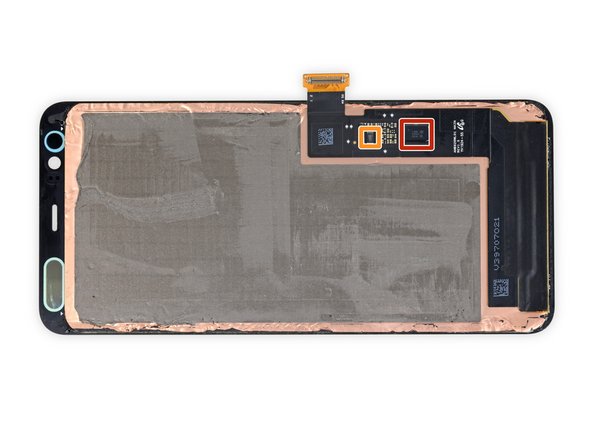crwdns2935425:013crwdne2935425:0






-
Google gifted this Pixel with a supersmooth (sometimes) 90 Hz screen—a rarity thus far, even amongst the flagship-iest of smartphones.
-
Google also made sure nobody could take it from the Pixel without a struggle. Strong perimeter adhesive + screen layers going literally to the edge + giant duct-tape-like adhesive pad = screen does not want to come out intact.
-
In theory there's no reason to do this—only broken screens need be removed this way. But this is not a fun process for replacing an (all too common) broken screen.
-
On board, we also find a somewhat unexpected chip package from STMicroelectronics, likely a capacitive touchscreen controller.
-
GigaDevice GD25LH80C 8 Mb serial flash memory
| [* black] Google gifted this Pixel with a supersmooth ([https://www.theverge.com/2019/10/23/20929090/google-pixel-4-screen-smooth-display-refresh-rate-lighting-conditions-software-update|sometimes|new_window=true]) 90 Hz screen—a rarity thus far, even amongst the flagship-iest of smartphones. | |
| [* black] Google also made sure ''nobody'' could take it from the Pixel without a struggle. Strong perimeter adhesive + screen layers going literally to the edge + giant duct-tape-like adhesive pad = screen does not want to come out intact. | |
| [* black] In theory there's no reason to do this—only broken screens need be removed this way. But this is not a fun process for replacing an (all too common) broken screen. | |
| [* icon_note] At least in this case, the result is interesting: this display is manufactured by Samsung! This comes as something of a surprise, given that Samsung has not yet put a 90 Hz display ''[guide|125590|even in its own smartphones|stepid=242810|new_window=true].'' | |
| - | [* red] On board, we also find a somewhat unexpected chip package from STMicro, likely a capacitive touchscreen controller. |
| + | [* red] On board, we also find a somewhat unexpected chip package from STMicroelectronics, likely a capacitive touchscreen controller. |
| + | [* orange] GigaDevice GD25LH80C 8 Mb serial flash memory |
crwdns2944171:0crwdnd2944171:0crwdnd2944171:0crwdnd2944171:0crwdne2944171:0